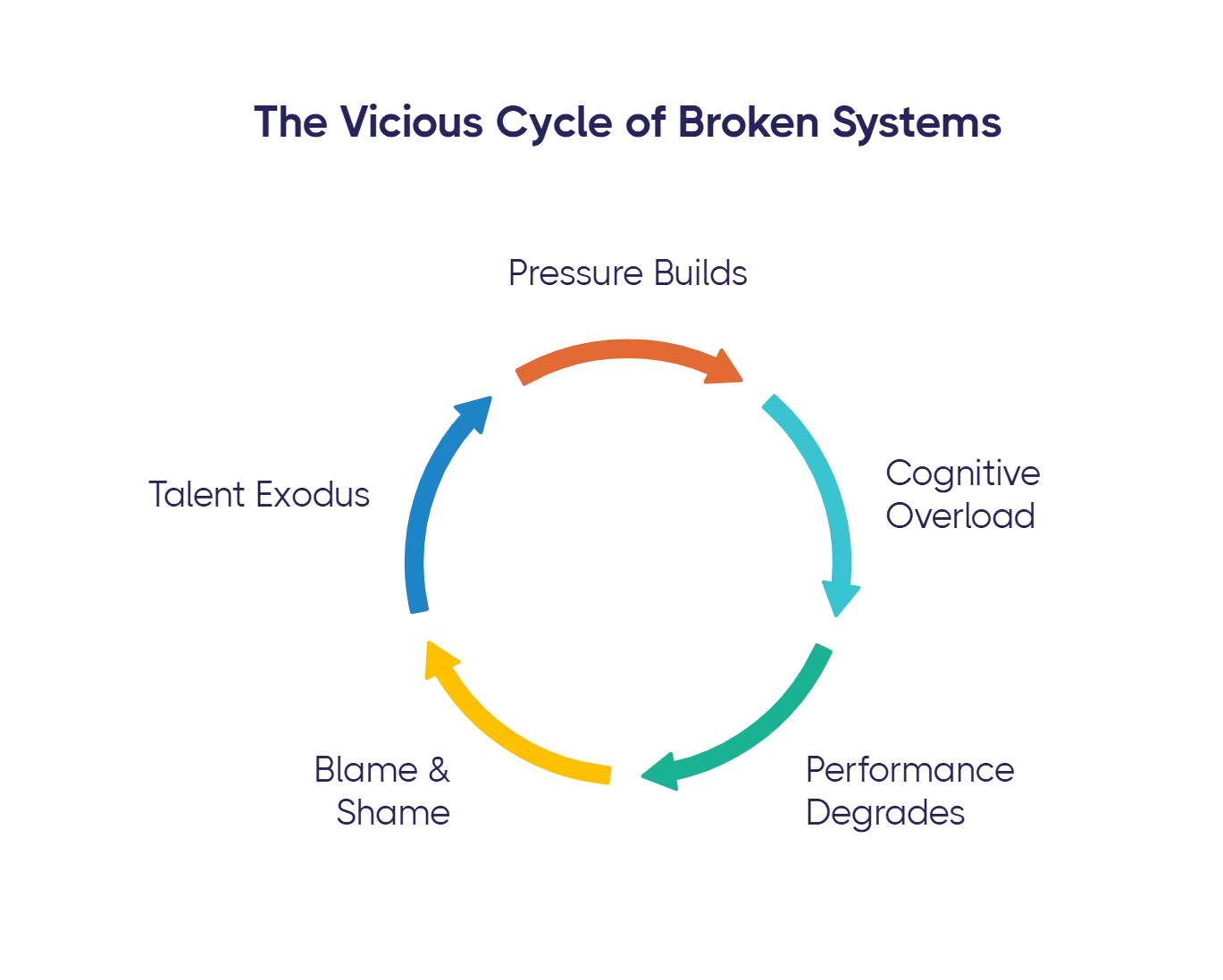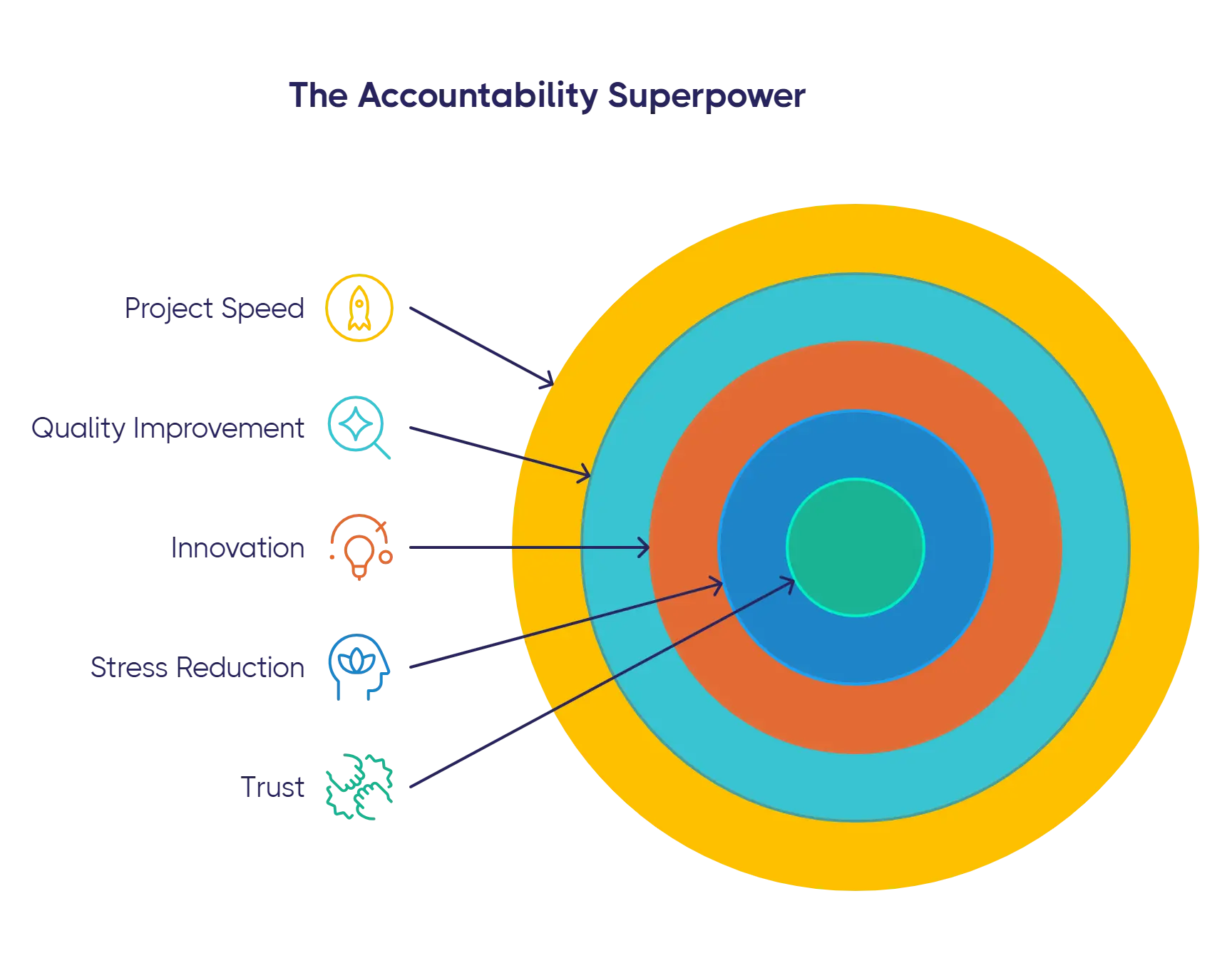Tired of blaming people for accountability failures? The real problem is your system. Learn how communication breakdowns and misaligned metrics sabotage execution.
Here's a number that should keep you up at night: $62.4 million. That's what the average company loses annually due to communication breakdowns. Not market downturns. Not competitive pressures. Just plain old communication failures that torpedo plan execution before it even has a chance.
But here's the kicker—when these failures happen, who gets blamed? The person who "dropped the ball”, the team that "didn't follow through", or the department that "lacks accountability"? We've created an entire corporate mythology around individual accountability failures while completely ignoring the elephant in the room: the system itself is broken.
In this post, we're going to dismantle the myth that accountability problems are people problems. We'll explore why communication breakdowns and measurement misalignment create impossible conditions for success, and more importantly, how to fix the system instead of blaming the people trapped within it.
The Accountability Lie We Tell Ourselves
Picture this: You're in yet another meeting about "improving accountability." The usual suspects are trotted out—clearer KPIs, more frequent check-ins, maybe a new tracking tool. Someone invariably mentions that "what gets measured gets managed," nodding sagely as if they've just discovered fire.
Here's what they don't tell you... that quote? It's actually a warning, not a prescription. When V.F. Ridgway wrote about measurement in 1956, he was cautioning against the "indiscriminate use and undue confidence" in performance measurements. He warned that the side effects could "outweigh the benefits."
But somewhere along the way, we stopped treating it like a warning. We started treating it like instructions — as if more measurement is always better. It’s not.
Organizations are drowning in metrics that end up causing the very problems they were meant to fix.
When Communication Fails: The $62 Million Problem
Let's talk about communication—or rather, the spectacular ways it fails in most organizations. Research by David Grossman found that companies with 100,000 employees lose an average of $62.4 million annually due to communication failures. That's not a typo. That's real money vanishing into the organizational ether because people can't effectively share information.
But it gets worse. In healthcare, communication breakdowns don't just cost money—they cost lives. The Joint Commission found that communication failures are the leading root cause of sentinel events in hospitals, contributing to between 44,000 and 98,000 preventable deaths annually in the U.S. alone.
When a medication error occurs because the handoff communication between shifts is unclear, OR a project update slips through the cracks, and now two departments are duplicating work, these aren't failures of individual doctors or nurses, or inept project managers... These are system failures.
The Three Leaks Sinking Your Communication Ship
.png)
After diving deep into the research, I've identified three ways communication systematically undermines accountability:
1. The Clarity Crisis Ever received an email that left you more confused than before you read it? You're not alone. Organizations excel at creating communication that sounds important but means nothing. "We need to leverage our synergies to drive stakeholder value" might win buzzword bingo, but it doesn't tell anyone what they're actually supposed to do.
2. The Consistency Catastrophe Here's a fun game: Ask five different managers in your organization what the top priority is. If you get five different answers, congratulations—you've identified a consistency problem. When leadership says one thing in the all-hands meeting and something entirely different in department meetings, accountability becomes a guessing game.
3. The Reliability Roulette Some organizations treat communication like a lottery. Maybe you'll hear about that critical change. Maybe you won't. Maybe the information will be accurate. Maybe it's already outdated. When people can't rely on official communication channels, they create their own—hello, rumor mill!
The Measurement Trap: When Good Metrics Go Bad
Remember Wells Fargo? They had aggressive sales goals, measured by crystal-clear metrics: eight products per customer. Specific. Measurable. Relevant.
Also, completely toxic.
Those "clear" metrics drove employees to create 3.5 million fake accounts. Not because the employees were inherently dishonest, but because the system made fraud the logical response to impossible demands. This wasn't a failure of individual ethics—it was "administrative evil," where organizational systems pressure good people to do bad things.
Your Brain on Metrics: The Cognitive Overload Nobody Talks About
Here's something fascinating from cognitive science: our working memory can effectively handle about 3-4 items at once. Not seven, as the old research suggested. Three to four. That's it.
Now think about your current role. How many metrics are you tracking? How many goals are you juggling? How many "priorities" are supposedly equal? If it's more than four, you're not just setting yourself up for failure—you're fighting basic human biology.
Research shows that task-switching (what we mistakenly call "multitasking") can reduce productivity by up to 40%. Every time you switch between tracking different metrics or managing different accountabilities, your brain pays a switching cost.
It's like running a computer with too many programs open—eventually, the whole system crashes.
Gaming the Numbers: When Hitting the Target Misses the Point
When measurement becomes the primary accountability mechanism, something predictable happens: people get creative. Not creative in the "innovation" sense, but creative in the "how can I make these numbers look good" sense.
Take the UK's National Health Service. They implemented a 4-hour emergency room wait time target. Sounds reasonable, right? Except hospitals started doing things like:
- Keeping patients in ambulances until they could be seen within the window
- Discharging and immediately readmitting patients to reset the clock
- Redirecting complex cases to other departments
The metric improved. Patient care? Not so much.
Universities aren't immune either. When research output is measured by publication count, what happens?
- A flood of minimal-contribution papers
- "Salami slicing" (splitting one study into multiple papers)
- Citation rings where researchers artificially boost each other's metrics
This isn't cheating—it's adaptation. When you create a system that rewards hitting numbers over actually achieving the root goals, don't be surprised when people optimize for the numbers.
System Failures in the Wild: Learning from the Disasters
Let's examine some spectacular system failures that everyone initially blamed on individuals:
NASA and the Normalization of Deviance
The Challenger disaster wasn't caused by one bad decision. It was caused by a system that slowly normalized increasingly dangerous practices. Engineers raised concerns about O-ring failures, but the organizational culture and communication systems failed to escalate those concerns effectively.
The phrase "normalization of deviance" describes how organizations gradually accept lower standards. It's not that people suddenly become reckless—it's that the system slowly shifts what is considered acceptable. Without clear communication channels and proper accountability structures, warning signs become background noise.
BP's Deep Water, Deeper Problems
The Deepwater Horizon disaster killed 11 people and caused the largest marine oil spill in history. The initial reaction? Blame the workers on the rig. The reality? A systematic failure of:
- Communication between multiple contractors
- Cost-cutting culture that deprioritized safety
- Measurement systems that rewarded speed over safety
- Accountability structures that diffused responsibility
The investigation revealed that warning signs were everywhere, but the system wasn't designed to aggregate and escalate them effectively. Individual workers were accountable for their specific tasks, but no one was accountable for the system itself.
The Vicious Cycle: How Broken Systems Break People

Broken accountability systems don't just fail to produce results—they actively damage the organization and its people:
Stage 1: The Pressure Builds - When communication is unclear and metrics are misaligned; people experience chronic stress. They're constantly trying to decode mixed messages and hit moving targets.
Stage 2: Cognitive Overload Sets In - Research shows that stress and anxiety reduce working memory capacity. So just when people need maximum cognitive resources to navigate the broken system, the system itself is depleting those resources.
Stage 3: Performance Degrades - With reduced cognitive capacity and increased stress, mistakes multiply. Quality suffers. Innovation disappears. People go into survival mode.
Stage 4: Blame and Shame When results inevitably disappoint, the organization looks for someone to blame. After all, the system can't be wrong—it must be the people who are failing.
Stage 5: Talent Exodus The best people—the ones with options—leave. The organization is left with those who can't escape or have given up trying. The system gets worse.
Building Accountability Systems That Actually Work
.webp)
Enough doom and gloom. Let's talk solutions. Based on extensive research and real-world experience, here's how to build accountability systems that enhance rather than undermine performance:
1. Communication: Make It Crystal Clear
Create a Single Source of Truth - Stop the madness of conflicting messages. Establish one authoritative source for priorities, goals, and expectations. If people have to triangulate between multiple communications to understand what's expected, you've already failed.
Use the Grandma Test - Could your grandmother understand what you're asking people to do? If not, it's too complex. Clear communication uses simple language, specific examples, and concrete next steps.
Build Feedback Loops, Not Echo Chambers - Communication isn't broadcasting—it's dialogue. Create mechanisms for people to ask questions, raise concerns, and confirm understanding without fear of looking stupid.
2. Measurement: Less Is More
Respect the Rule of Three - Remember that working memory limit? Apply it ruthlessly. No more than 3-4 key metrics per person or team. If everything is a priority, nothing is.
Measure What Matters, Not What's Easy - Just because something can be measured doesn't mean it should be. Focus on metrics that directly connect to real outcomes, not vanity metrics that make reports look good.
Make Gaming Harder Than Performing - Design metrics that are difficult to game without actually improving performance. Use multiple indicators, look for balance, and regularly audit for unintended consequences.
3. Structure: Design for Human Limits
Sequential, Not Simultaneous - Instead of dropping ten new initiatives on people at once, introduce changes sequentially. Let people master one before adding another. Your timeline might be longer, but your success rate will be higher.
Clear Escalation Paths - When problems arise (and they will), people need to know exactly where to go and what to do. Create clear, safe channels for escalating issues without fear of retribution.
Regular System Audits - Just as you audit financial systems, audit your accountability systems. Are they producing the intended results? What unintended consequences have emerged? Where are the friction points?
The Technology Factor: Tools That Help (and Hurt)
Technology can either amplify system problems or help solve them. Here's how to ensure your tech stack supports rather than sabotages accountability:
Integration Is Everything - If your project management tool doesn't talk to your documentation system, which doesn't integrate to your communication platform, you've created an accountability nightmare. Every manual handoff is a potential failure point.
Visibility Without Surveillance - Good accountability tools make work visible without making people feel watched. There's a fine line between quality control and Big Brother—respect it.
Automation with Intelligence - Automate routine accountability tasks (like status updates or reminder notifications) but keep human judgment in the loop for complex decisions. The goal is to reduce cognitive load, not replace critical thinking.
A Thought Experiment: The Accountability Superpower

Imagine if everyone in your organization had a superpower: perfect clarity about what they're responsible for, how their work connects to larger goals, and what success looks like. No mixed messages. No competing priorities. No impossible metrics.
What would change?
Outcome 1: Projects would move faster because people wouldn't waste time decoding expectations
Outcome 2: Quality would improve because efforts would focus on what actually matters
Outcome 3: Innovation would flourish because cognitive resources wouldn't be drained by system navigation
Outcome 4: Stress would decrease because uncertainty—the biggest stress driver—would be minimized
Outcome 5: Trust would build because promises could actually be kept
This isn't a fantasy. This is what happens when you fix the system instead of blaming the people.
Check out our favorite accountability tools in ClearPoint Strategy. 🚀
The Bottom Line: Want Better Results? Build a Better System
Here's the uncomfortable truth: that person you think has an "accountability problem"? They're probably drowning in a broken system.
The team that "can't execute" → Are they receiving contradictory messages and impossible mandates?
The department that "lacks ownership" → Are they being measured on things they can't control?
We've spent decades perfecting the art of individual blame while ignoring systemic dysfunction. We've created elaborate performance management systems, accountability frameworks, and tracking tools—all designed to fix people who aren't broken.
Meanwhile, the real culprits—unclear communication, misaligned metrics, and impossible cognitive demands—continue their destructive work, costing millions in lost productivity and immeasurable amounts in human potential.
It's time for a new approach. Instead of asking "Who's accountable?" start asking:
- Is our communication clear, consistent, and reliable?
- Are we measuring what matters or just what's measurable?
- Are we respecting human cognitive limits or pretending they don't exist?
- Are we creating conditions for success or setting people up to fail?
Because at the end of the day, accountability isn't about finding someone to blame when things go wrong. It's about creating systems where things are more likely to go right. The choice is yours: Keep blaming people and watching the same failures repeat, or fix the system and watch your organization transform.
What gets measured may get managed, but what gets communicated clearly, measured intelligently, and structured humanely? That gets done.
And that's the kind of accountability we should all be striving for.
Ready to build a better system? Schedule a demo to see how ClearPoint can help you achieve more of your strategy.

.svg)
.png)




